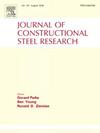无预应力碟形弹簧的自定心摩擦耗能支撑:概念验证
IF 4
2区 工程技术
Q1 CONSTRUCTION & BUILDING TECHNOLOGY
引用次数: 0
摘要
自中心消能支撑(scb)在地震中具有恢复和消能的双重能力。然而,传统scb的变形能力往往受到弹性自定心构件所需的高预应力的限制,限制了其在强震下的滞回性能。为了解决这个问题,本研究引入了一种新型的非预应力碟形弹簧自定心支撑(NP-SCB)。介绍了NP-SCB的结构、工作机理和理论恢复力模型。为了验证这一概念,然后进行了有限元分析,以评估关键参数,包括滑动摩擦力(Fs)和盘形弹簧刚度(Kd),对其滞回性能,自定心行为和能量耗散能力的影响。结果表明,所建立的恢复力模型能够准确地预测NP-SCBs的滞后响应,呈现出明显的“旗形”和“尖峰形”曲线。耗散能力与再激活位移密切相关,可通过减小Fs或增大Kd来增强耗散能力。NP-SCB具有优异的自定心性能,最大残余轴向应变仅为0.046%。与传统预应力SCBs相比,NP-SCBs的变形能力提高了9.86% ~ 500%。通过优化滑动摩擦力和盘形弹簧刚度,可以增强NP-SCB的抗震弹性。本文章由计算机程序翻译,如有差异,请以英文原文为准。
Self-centering friction energy dissipation brace with non-prestressed Disc Springs: Concept validation
Self-centering energy dissipation braces (SCBs) provide both recovery and energy dissipation capacities during earthquakes. However, the deformation capacity of conventional SCBs is often constrained by the high-level prestress required in elastic self-centering components, limiting their hysteretic performance under severe earthquakes. To address this issue, this study introduces a novel self-centering brace with non-prestressed disc springs (NP-SCB). The configuration, working mechanism, and theoretical restoring force model of the NP-SCB are presented. In order to validate the concept, finite element analyses were then performed to evaluate the effects of key parameters, including sliding friction force (Fs) and disc spring stiffness (Kd), on its hysteretic performance, self-centering behavior, and energy dissipation capacity. The results revealed that the proposed restoring force model accurately predicted the hysteretic response of NP-SCBs, characterized by distinct “flag-shaped” and “spike-shaped” curves. The energy dissipation capacity was closely associated with the reactivation displacement and can be enhanced by reducing Fs or increasing Kd. The NP-SCB exhibited excellent self-centering performance, with a maximum residual axial strain of only 0.046 %. Compared to traditional pre-stressed SCBs, NP-SCBs showed a 9.86 % to 500 % improvement in deformation capacity. NP-SCB's seismic resilience can be enhanced by optimizing sliding friction force and disc spring stiffness.
求助全文
通过发布文献求助,成功后即可免费获取论文全文。
去求助
来源期刊

Journal of Constructional Steel Research
工程技术-工程:土木
CiteScore
7.90
自引率
19.50%
发文量
550
审稿时长
46 days
期刊介绍:
The Journal of Constructional Steel Research provides an international forum for the presentation and discussion of the latest developments in structural steel research and their applications. It is aimed not only at researchers but also at those likely to be most affected by research results, i.e. designers and fabricators. Original papers of a high standard dealing with all aspects of steel research including theoretical and experimental research on elements, assemblages, connection and material properties are considered for publication.
 求助内容:
求助内容: 应助结果提醒方式:
应助结果提醒方式:


